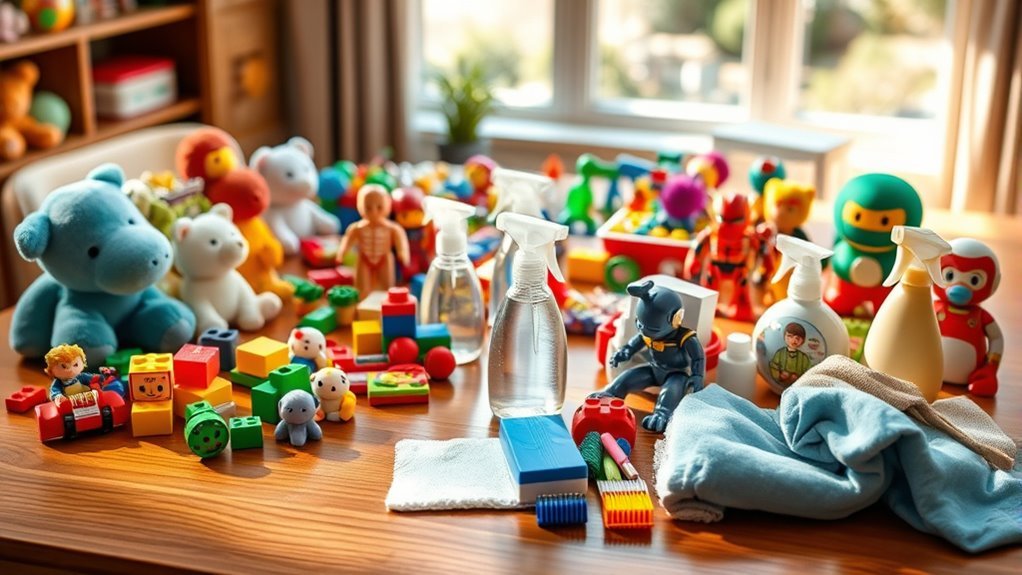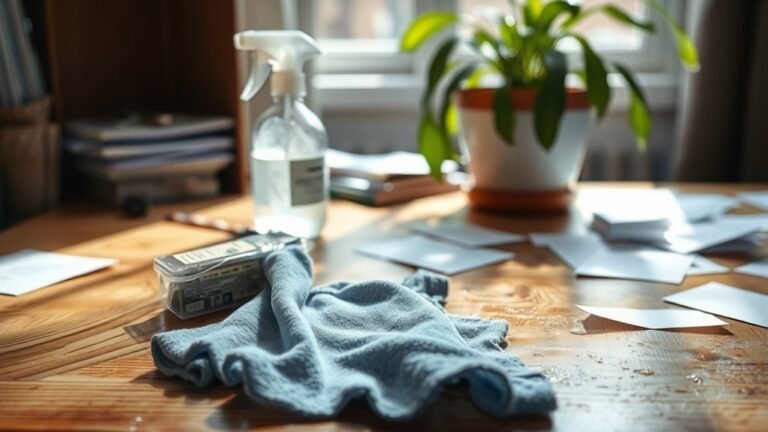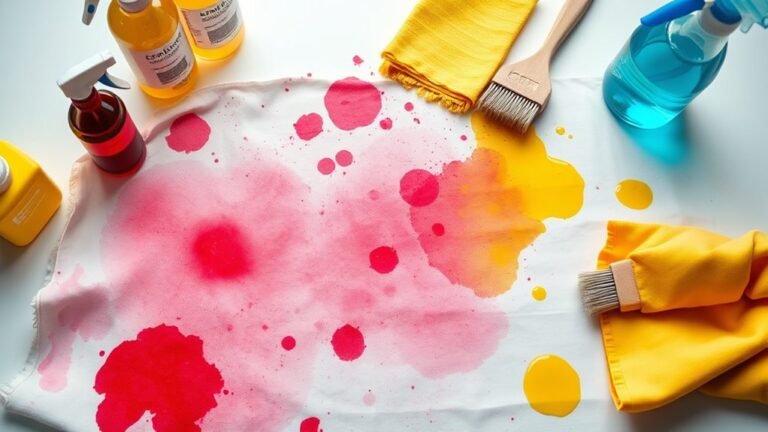Step-By-Step Guide to Cleaning Toys
To clean your child’s toys safely, first identify their material—soft plush, hard plastic, or electronic—and gather supplies like mild detergent, soft cloths, and brushes. Spot-clean or hand wash plush toys with cold water, and wash plastic toys in warm soapy water, rinsing thoroughly. Remember to dry toys completely to prevent mold, using air or sun drying when possible. Careful cleaning keeps toys safe and fresh, and if you want, you can explore tips for handling electronic toys and organized storage next.
Identifying Different Types of Toys

Anyone who’s ever looked at a pile of toys knows they come in all shapes, sizes, and materials. When identifying different types of toys, you’ll want to distinguish between educational toys designed to stimulate learning and sensory toys that engage touch, sight, and sound. Educational toys often include puzzles, building blocks, or alphabet games, encouraging cognitive development. Sensory toys, on the other hand, might be textured balls, squishy figures, or toys with lights and sounds, perfect for stimulating your child’s senses. Recognizing these categories helps you understand how to clean them properly without damaging delicate parts. Knowing the material—plastic, fabric, or wood—is also key, as each requires a different cleaning approach. This awareness gives you the freedom to maintain your child’s toys safely and effectively.
Gathering Cleaning Supplies
Before you start cleaning, it’s important to gather the right supplies, including essential materials and safe cleaning agents that won’t harm your child’s toys. Choosing gentle, non-toxic products helps keep toys safe for playtime. Also, organizing your supplies neatly will make the process quicker and less stressful.
Essential Cleaning Materials
To effectively clean your child’s toys, you’ll need a handful of essential materials that are both safe and efficient. Start with soft cloths or sponges, perfect for gentle scrubbing without damaging delicate surfaces. Have a soft-bristle brush handy for stubborn dirt or textured toys. A spray bottle can make applying cleaning solutions easier and more controlled. Don’t forget gloves to protect your hands, especially when using stronger cleaners. When selecting products, opt for eco friendly cleaners that align with toy maintenance tips emphasizing safety and environmental care. These materials help you maintain hygiene without compromising your freedom to choose green options. Having these tools ready simplifies the cleaning process, letting you focus on what matters: keeping your child’s playthings fresh and safe.
Safe Cleaning Agents
Choosing the right safe cleaning agents is essential for protecting both your child’s health and the toys themselves. You want to avoid harsh chemicals that can irritate sensitive skin or damage delicate materials. Opt for eco friendly cleaners that use natural ingredients; they’re effective yet gentle, allowing you to maintain a healthy environment without compromising cleanliness. Disinfectant alternatives like vinegar solutions or diluted hydrogen peroxide work well for sanitizing without harmful residues. Remember, less is more—simple, safe agents often do the trick without overwhelming you. This approach gives you the freedom to clean confidently, knowing you’re prioritizing safety and sustainability. By choosing wisely, you keep playtime fun and worry-free, ensuring toys stay clean and safe for all the adventures ahead.
Storage and Organization
A few well-organized storage solutions can make gathering your cleaning supplies much easier and less stressful. Start by designating a specific bin or caddy solely for your toy cleaning essentials. This keeps everything from wipes to sprays in one spot, so you’re not hunting around. Using clear containers helps maintain toy organization by letting you quickly see what’s inside. Labeling each container can further reduce clutter and speed up your routine. Remember, clutter reduction in your cleaning area frees up mental space, making the process feel less like a chore. When supplies are easy to access and well-organized, you’ll feel more in control and ready to clean toys efficiently, giving you more freedom to enjoy tidy playtime spaces.
Cleaning Soft and Plush Toys
Although soft and plush toys can be comforting companions, they also tend to collect dust, dirt, and germs over time. For effective soft toy care, start by checking the label for washing instructions—some can go in the machine, while others need gentle hand washing. Use mild detergent and cold water to preserve fabric quality. After washing, squeeze out excess water without wringing, then air-dry thoroughly to prevent mold. Regular plush toy maintenance also includes spot-cleaning stains promptly with a damp cloth and mild soap. Don’t forget to fluff toys after drying to restore their softness. By following these simple steps, you’ll keep your child’s favorite companions clean, safe, and ready for endless play, giving you peace of mind and freedom from worry.
Washing Plastic and Hard Toys

When it comes to washing plastic and hard toys, you’ve got several easy and effective options to keep them clean and safe for your child. First, check the toy’s label for information on the types of plastics used, as some materials can withstand warm water and mild soap, while others need gentler care. For most hard plastic toys, a simple wash with warm soapy water and a soft cloth works well. Avoid harsh chemicals that might compromise toy safety or the plastic’s integrity. Rinse thoroughly to remove any residue, then air dry completely. If toys have small crevices, use a soft brush to reach dirt. Keeping these toys clean not only guarantees your child’s health but also extends the toy’s lifespan, giving you both more freedom to enjoy playtime.
Sanitizing Electronic Toys
Cleaning plastic and hard toys is straightforward, but electronic toys require a bit more care to avoid damaging their components. When sanitizing electronic toys, you’ll want to use gentle cleaning techniques that prioritize electronic safety. First, remove batteries to prevent any risk of short circuits. Use a soft cloth slightly dampened with a mild soap solution or a disinfectant wipe safe for electronics. Avoid soaking or submerging the toy, as moisture can damage internal parts. Pay attention to crevices using a cotton swab, but don’t let liquid seep inside. After cleaning, allow the toy to air dry completely before reinserting batteries. By following these careful steps, you can keep your child’s electronic toys clean and safe without limiting their freedom to play.
Drying and Storing Clean Toys

Once your toys are clean, it’s important to dry them thoroughly to prevent mold and bacteria growth. You’ll want to use effective drying methods that suit the toy’s material and design. After drying, proper storage will keep your toys safe, organized, and ready for the next playtime.
Effective Toy Drying Methods
To keep toys safe and ready for play, you’ll need to dry them thoroughly after washing. Choosing the right drying technique helps avoid mold and keeps toys fresh. Natural drying is often the best choice—it’s gentle and effective.
| Drying Method | Benefits |
|---|---|
| Air Drying | No chemicals, eco-friendly |
| Towel Drying | Quick, removes excess moisture |
| Sun Drying | Natural disinfectant, freshens |
| Dryer (Low Heat) | Fast, good for fabric toys |
| Fan Drying | Speeds up air drying indoors |
Pick a method that fits your schedule and toy type. With these drying techniques, you’ll keep toys clean and safe without hassle.
Proper Toy Storage Tips
Properly storing clean toys is just as important as drying them well—you’ll want to keep them organized, dry, and protected from dust or damage. Here’s how to do it effectively:
- Use clear toy bins to separate different types of toys, making it easy to find and put them away.
- Opt for open shelves or cubbies for shelf organization, so toys air out and stay dry.
- Avoid overcrowding bins or shelves; giving toys space helps prevent moisture buildup and damage.
- Store toys in a cool, dry place away from direct sunlight to maintain their quality and color.
Frequently Asked Questions
How Often Should I Clean My Child’S Toys?
You should adjust your cleaning frequency based on how often your child plays and the toy materials. For plastic or rubber toys, cleaning once a week is usually enough, but fabric or wooden toys might need gentler, less frequent cleaning. If your child’s toys often get dirty or go outside, you might want to clean them more regularly. Trust your instincts, and keep things practical to maintain a safe, happy play environment.
Can Homemade Cleaning Solutions Be Safe for Toys?
Like a gentle breeze, homemade cleaning solutions made with natural ingredients can be safe for your child’s toys if you’re careful. You’ve got to take into account the toy materials—some plastics or fabrics might react poorly to vinegar or baking soda. Always test a small spot first, and avoid harsh chemicals. This way, you keep things clean without risking damage, giving you freedom to choose safe, eco-friendly options for your little one’s playthings.
Are There Specific Toys That Should Never Be Cleaned With Water?
You should avoid cleaning battery operated toys with water since moisture can damage their electronics or cause corrosion. Instead, wipe them gently with a damp cloth. Plush toys can usually be washed, but some delicate or vintage ones may be harmed by water, so check labels first. If you want to keep your toys safe while cleaning, consider these tips to enjoy freedom from worry and keep everything fresh without causing damage.
How Do I Remove Tough Stains From Toys?
Imagine stains as stubborn shadows clinging to your toys. To banish them, you’ll want to use gentle stain removal techniques like a soft brush with mild soap or baking soda paste. Toy cleaning products designed for delicate surfaces can also work wonders without damage. Always test a small area first, so you don’t trap stains or harm the toy. This way, you keep your child’s treasures fresh and ready for endless play.
Is It Necessary to Disinfect Toys During Flu Season?
Yes, it’s definitely a smart move to disinfect toys during flu season. Using effective disinfecting methods helps reduce germs that cause illness, so you’re actively supporting flu prevention. You don’t have to spend hours—simple solutions like diluted bleach or alcohol wipes work well. Keeping toys clean not only protects you and your loved ones but also gives you peace of mind, letting you enjoy your freedom without worry.






